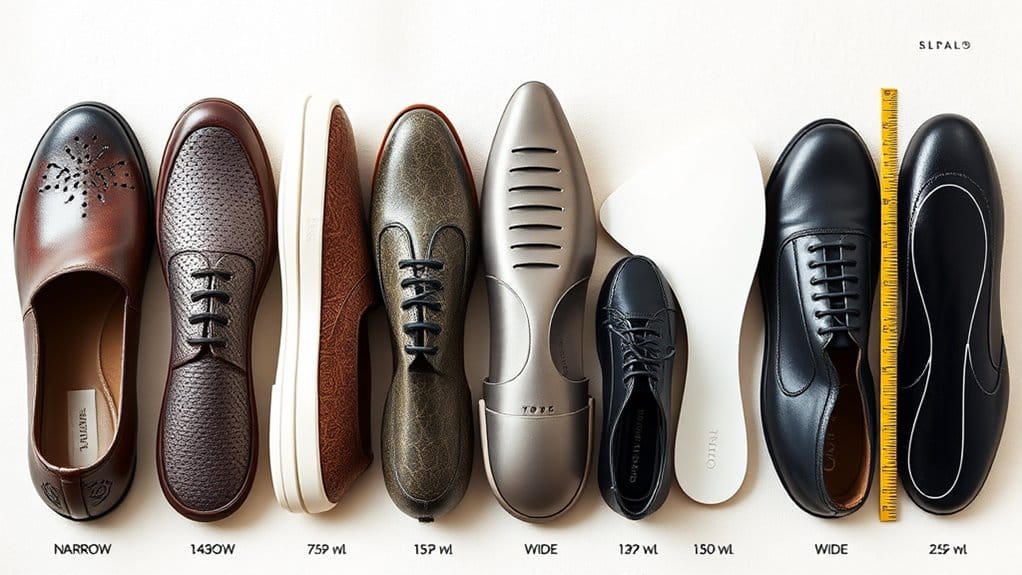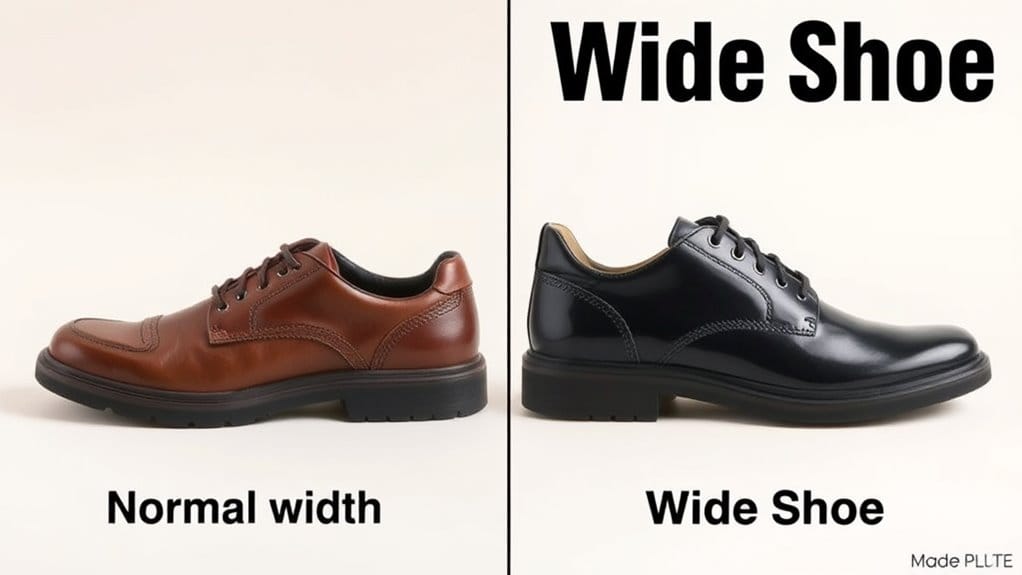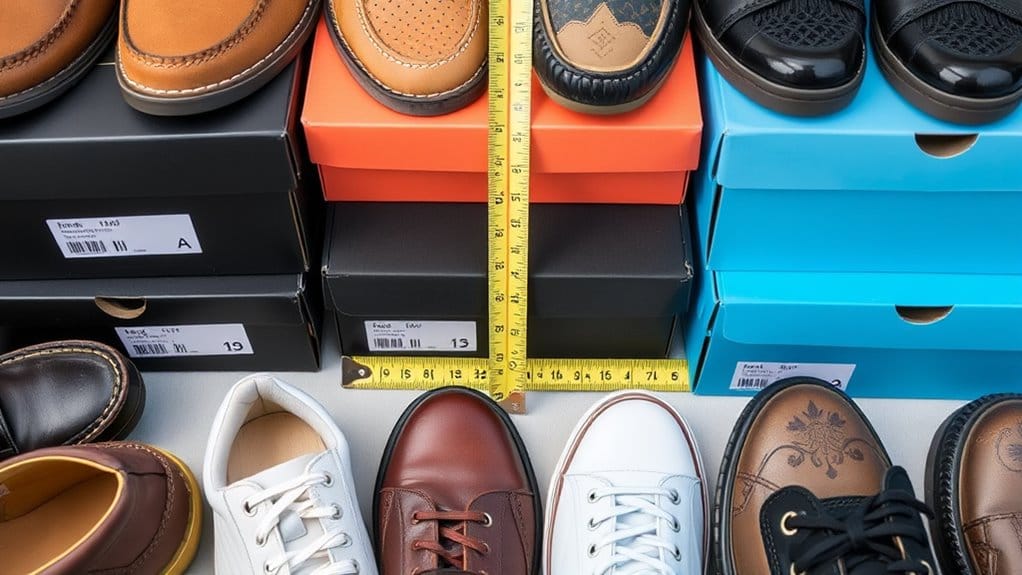This post contains affiliate links. As an Amazon Associate, we earn from qualifying purchases.
If your toes feel cramped, bunched together, or if you’ve developed blisters on the outer edges, you might need wide shoes. Numbness or tingling sensations can also indicate your footwear isn’t providing enough room. Other signs include overlapping toes or existing foot conditions like bunions. It’s important to measure your foot width accurately to find the right fit. Discovering more about shoe styles and width classification can help enhance your comfort and foot health.
Key Takeaways
- If your toes feel cramped or bunched in your current shoes, you may need wider footwear.
- Overlapping toes or spilling over the sides of shoes can indicate a need for wide shoes.
- Frequent blisters on the outer edges of your big toe or pinky toe suggest inadequate width in your footwear.
- Numbness or tingling sensations in your feet may signify nerve compression from narrow shoes.
- Existing foot conditions like bunions or hammertoes are signs that wide shoes could enhance your comfort.
Signs You May Need Wide Shoes
When your toes feel cramped or bunched together, it might be time to contemplate wide shoes.
If you notice your toes overlapping in the toe box or spilling over the sides, that’s a clear sign your current footwear isn’t a proper fit.
Experiencing blisters on the outer edges of your big toe or pinky toe could mean you need extra space.
Numbness or tingling sensations in your toes often arise from nerve compression, indicating wider shoes may help.
Existing foot conditions like bunions or hammertoes further emphasize the need for a wide fit to accommodate discomfort.
Ensuring your shoes fit properly is essential for overall foot health and comfort, so don’t hesitate to explore options that offer the necessary support.
Measuring Foot Width
To guarantee you find the right fit, measuring your foot width accurately is essential. Here’s how to get those precise measurements:
- Trace the outline of your foot on a piece of paper, keeping the pen vertical to capture the widest parts.
- Mark the widest part of your foot, usually at the base of the big toe and the outer edge of the pinky toe.
- Measure the distance between these points to determine your foot width.
- Use a Brannock device for accurate measurements and to identify if you need wide-width shoes.
Be certain to measure both feet, as they can vary in size.
This way, you can assure a comfortable fit that provides additional space for your feet.
Understanding Foot Width Classification

Knowing your foot width is just the first step in finding the right shoes.
Foot width classification includes narrow (A for women, C for men), medium (B for women, D for men), wide (D for women, E for men), and extra wide (2D for women, 4E for men).
Most people wear standard shoe width, which is typically medium. However, wide shoes are about one-eighth to one-fourth inch wider, providing extra space in the toe box size and forefoot width.
This added room enhances comfort, especially for individuals with wide feet.
Remember, shoe sizing varies by brand, so always check the specific sizing chart for an accurate fit.
This guarantees you get the right width for your feet.
Causes of Wide Feet
Wide feet can result from several factors, and understanding these causes can help you find the right footwear. Here are some common reasons you might’ve wider feet:
- Genetics: Family history often influences your foot size and shape.
- Aging: Over time, changes in ligaments and foot structure can lead to wider feet.
- Obesity: Increased weight can cause expansion and flattening of the foot arch.
- Pregnancy: Hormonal changes and swelling during pregnancy can temporarily widen your feet.
Additionally, medical conditions like diabetes, kidney disease, and heart problems can also lead to edema, resulting in wider feet.
Recognizing these causes is crucial for selecting the proper footwear to guarantee comfort and support.
Differences Between Normal-Width and Wide Shoes

While searching for the perfect pair of shoes, you might notice that normal-width and wide shoes differ markedly in design and fit.
Wide shoes typically feature a spacious toe box and midfoot area, providing a wider fit for those with foot conditions or unique foot shapes. They’re usually about one-eighth to one-fourth inch wider than normal-width shoes, accommodating your feet more comfortably.
Ill-fitting shoes can lead to issues like bunions and cramping, but wide shoes can considerably reduce these problems by offering improved support.
Additionally, wide-width options are designed to be deeper overall, ensuring a comfortable fit from front to back.
Choosing the right width can make all the difference in your daily comfort and foot health.
The Best Shoe Styles for Wide Feet
Finding the right shoe style can enhance your comfort considerably, especially if you have wider feet. You’ll want to explore options that provide a comfortable fit while also supporting wide feet.
Here are some of the best shoe styles for your needs:
- Lace-up shoes for adjustable fit
- T-bar strap sandals with adjustable straps
- Athletic shoes featuring a spacious toe box
- Sneakers designed in multiple width sizes
Brands like Clarks, Merrell, and Keen offer a variety of styles for wide feet, ensuring both comfort and style.
Look for shoes that come in half sizes to achieve that tailored fit. By choosing the right styles, you’ll enjoy better support and a more enjoyable wearing experience.
How Shoe Widths Are Labeled

Shoe widths are labeled using an alphabetical system that helps you identify the right fit for your feet. The standard width for men is D and B for women, serving as a baseline.
When choosing wide shoes, you’ll encounter width sizes like C/D for women and E for men. Extra wide options include 2E for men and 2D for women.
Keep in mind that not all brands offer the same width options, so always consult specific size charts. To guarantee your shoes fit correctly, consider your foot length and width.
Finding the right shoe size is essential for comfort, as shoes should feel comfortable without pinching or squeezing, allowing you to walk easily throughout the day.
Additional Considerations
Choosing the right shoe width isn’t just about the label; it’s also important to take into account other factors that affect fit and comfort.
Keep these considerations in mind:
- Regularly measure your feet for an accurate measurement, as size can change over time.
- Pay attention to activities; long hours of standing may require wide shoes for better support.
- Watch for signs of discomfort like redness or blisters, which indicate you might need wider footwear.
- If you have foot conditions such as flat feet or bunions, wider shoes can provide the proper fit and space you need.
Conclusion
If you find your shoes often feel tight or constricting, or you experience discomfort, it might be time to contemplate wide shoes. Remember, measuring your foot width can provide clarity, and understanding the differences between shoe widths helps you make informed choices. With the right fit, you’ll enjoy better comfort and support. Don’t hesitate to explore styles specifically designed for wide feet—they can make a world of difference in your daily comfort and overall foot health!

